Content [show]
Nowadays, rose seedlings with a closed root system (ZKS) are popular. These are roses that are sold already planted in containers. Such seedlings have their own advantages: they take root quickly and easily if planting in open ground is done correctly. How should they be planted?
How to care for rose seedlings before planting
Roses with a closed root system do not require immediate planting, in good conditions they can be stored for a long time, even until next year. It is best to place the pots of roses in a shady, windless place in the garden. To prevent the roots from overheating and drying out, it is advisable to dig the pots into the soil or sawdust.
Water your rose seedlings regularly before planting. Spraying the leaves with plain water is also helpful. If planting is delayed by more than 2-3 weeks, start feeding the seedlings weekly with liquid or soluble fertilizer for flower seedlings. What is needed is the seedling fertilizer used for potted plants. Specialized fertilizers for roses are not suitable when caring for seedlings. They are ideal for roses already planted in the ground, and if you put such fertilizer in a container, you can accidentally burn the roots.
If you bought rose seedlings at the end of winter or early spring, when the temperature is still below freezing outside, you will have to store and care for them indoors. How to do this, read the article: Save roses before planting.
Preparing a rose seedling for planting in the ground
Before planting, to make sure the rose is of good quality, carefully remove the seedling from the pot. Some firms use a metal mesh liner to make this easier. This is the best option because the mesh allows you to see the condition of the roots without breaking the earthy coma.
The roots should penetrate the entire earthy ball and have fresh white roots. Such good seedlings do not require additional processing, they are only soaked in water for 1-2 hours before planting.
It is not necessary to remove the metal mesh from rose seedlings during planting in the ground. It itself decomposes in the soil in 1-2 years and does not interfere with the development of roots.
There are other packaging options, such as a cardboard insert. It also retains a lump, but it is very problematic to determine the condition of the roots in it, especially if the roots have not yet sprouted through the walls. If you cannot see the root system or are in doubt about its quality, soak the seedling for several hours in a solution of a rooting stimulant. To obtain a solution, pour a sachet (10 g) of the stimulant in 7-8 liters of water and stir.
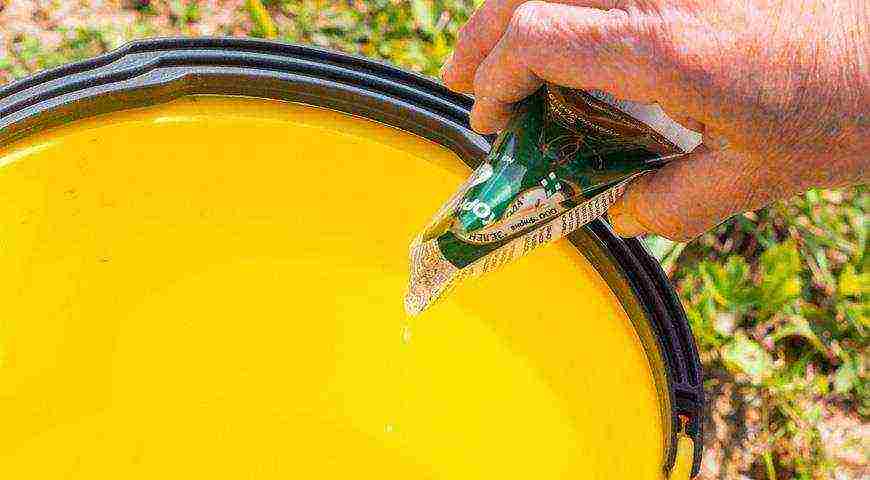
Submerge the rose roots in the solution directly in the container. If the container has a cardboard insert, then you can remove the plastic pot and soak the rose seedling in the cardboard. Processing time is 2-3 hours.
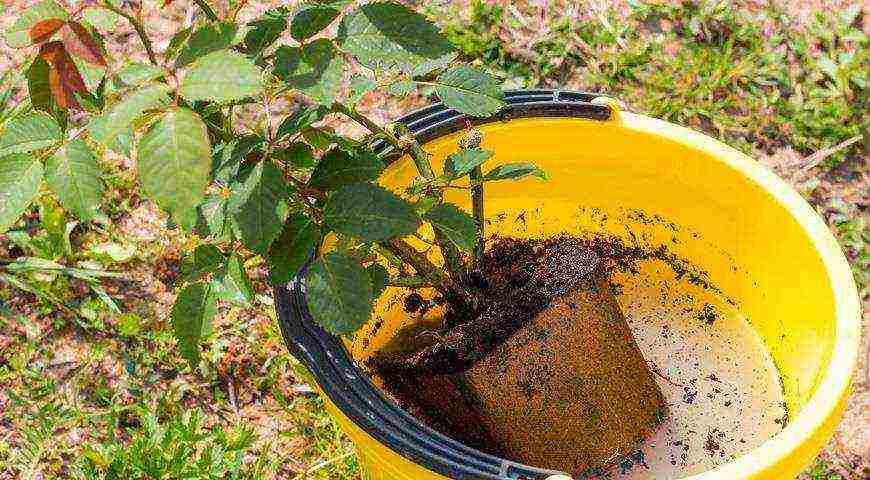
The solution of "Kornevin" for planting roses can be replaced with the solution of "Epin". Dissolve 40 drops in 2 liters of water and pour the container well by placing it in a bucket. Leave in solution for 2-3 hours.
Place for planting roses
A rose can grow in one place for decades, so the planting site requires careful preparation.
Prepare a landing pit. The size of the planting pit for the rose 60x60, depth 50 cm. Leave the upper fertile soil layer next to the pit, remove the lower soil layers. Soil for planting roses should be loose and fertile, so add humus or well-rotted compost, peat, sand, as well as 0.5 cups of double superphosphate to the soil from the top layer. Roses prefer neutral soil, so add additional additives to lower the acidity of the soil: 1-2 cups of wood ash or 1 cup of dolomite flour. Mix all components thoroughly and fill the planting hole with the mixture.
If you dug a planting hole just before planting a rose, then fill the mixture in layers, compacting each layer so that after watering the earth does not settle too much.
How deep should you plant a container rose?
After filling the hole, make a deepening in the soil so that the top of the coma, when planting, is 5-7 cm below the edge of the hole. It is better to plant roses with a slight deepening.
How to plant roses
Plant roses directly in the net or in a cardboard insert, but those parts of the insert where the roots have not yet germinated can be carefully removed.
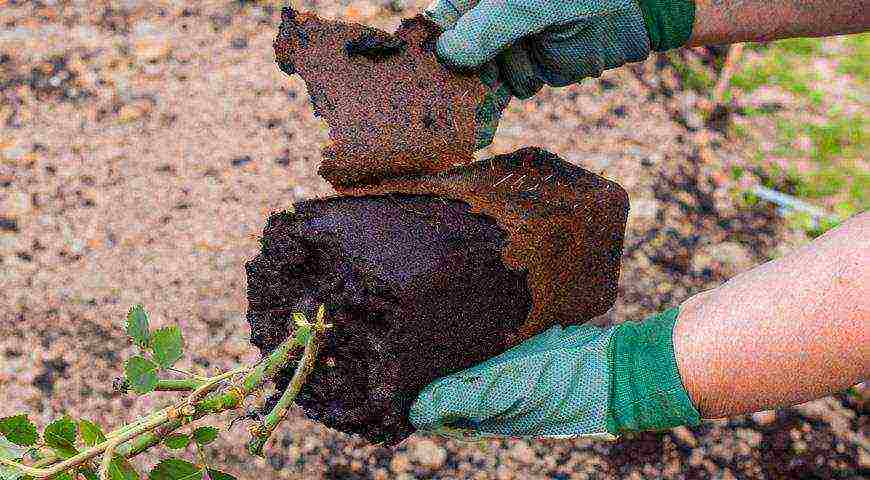
This will provide air access to the root system, and the rose will root better after planting.
Place the seedling in the prepared groove. Check again the level of deepening of the top of the earthen clod (5-7 cm) and pour the solution remaining after soaking into the hole.

Fill the hole with the remaining fertile mixture flush with the edge of the hole so that excess rainwater does not get into it during rains and does not stagnate.
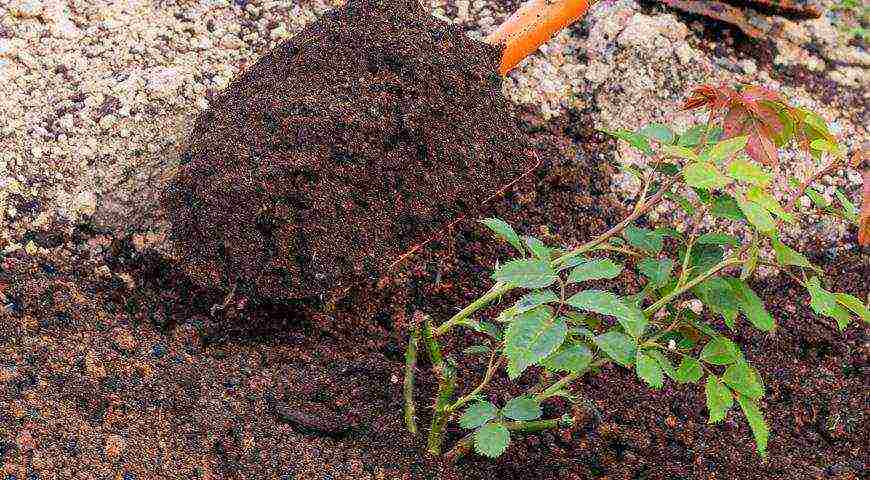
Water. For watering one rose seedling after planting, you need at least 8-10 liters of water in order to well wet all the soil in the planting pit.
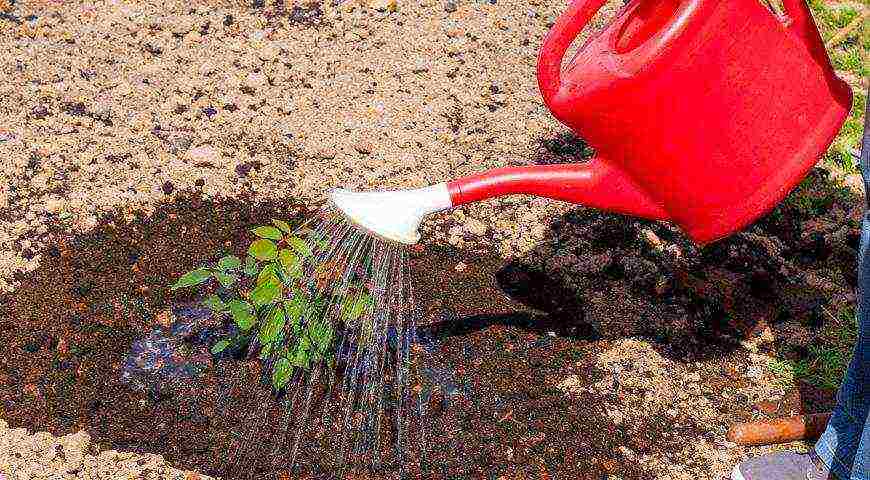
After watering, check the rose planting level again. If necessary, correct: either add soil, or, conversely, gently pull at the base of the bush so that the root collar is closer to the soil surface.
After watering, cover the surface with peat to avoid soil crust formation.
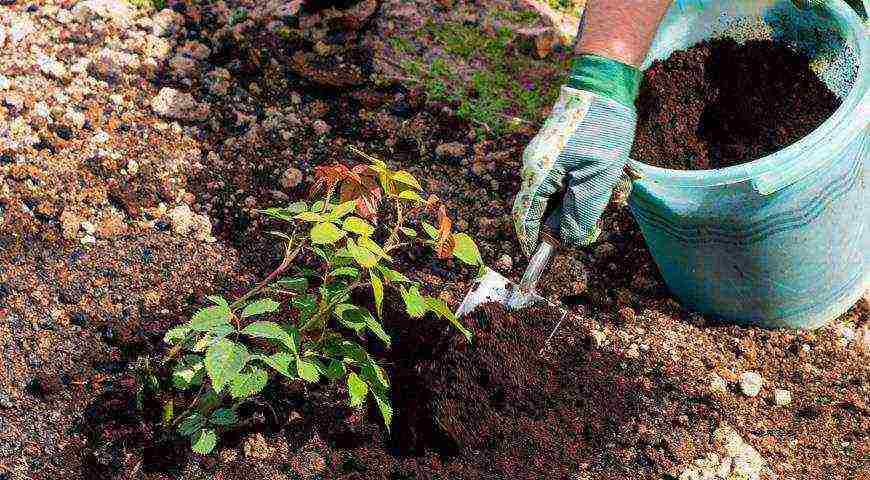
If the weather is hot, then in the first time after planting the roses should be shaded. The easiest way is to put small arcs and pull any covering material on them.
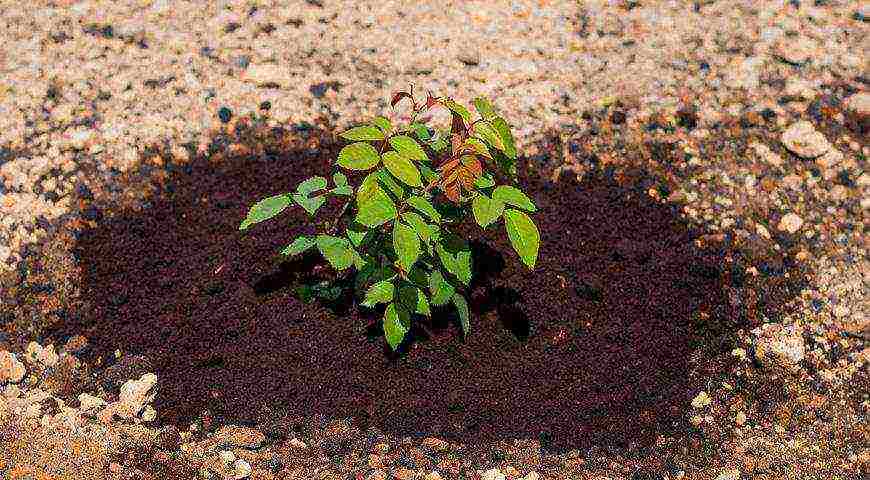
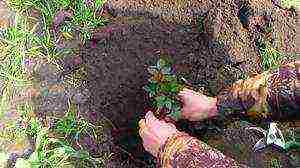 There is not a single garden plot where the owners do not grow such popular flowers as roses. A fragrant rose garden is the pride of any summer resident. In this article, we will look at how and when roses are planted in open ground.
There is not a single garden plot where the owners do not grow such popular flowers as roses. A fragrant rose garden is the pride of any summer resident. In this article, we will look at how and when roses are planted in open ground.
When to plant roses - this question causes controversy even among experienced gardeners. Some say that this should be done in the fall, while others only in the summer.
Autumn work on planting this culture is used in the southern territories of the country, where winters are mild and short and you don't have to worry that the roots of the plant will freeze. However, if the winter is very warm, then the planted bush will not overwinter.
Planting roses in open ground
Without a period of winter dormancy, it will be difficult for the plant to enter the active growth stage in the spring. At the same time, it is in the autumn, when it rains, that the culture will not need to be watered, it is not necessary to protect it from too active sun.
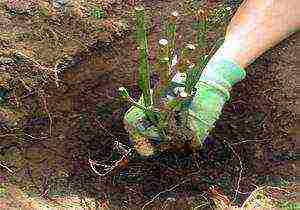 In general, rose bushes grown in closed pots can be planted during any period of the warm season of the year. It is only seedlings with open roots that should be cultivated in fall or spring. Any of the periods has its advantages, and we will talk about how to plant this culture in open land in the spring, so that in summer and until late autumn you can already admire its colorful buds.
In general, rose bushes grown in closed pots can be planted during any period of the warm season of the year. It is only seedlings with open roots that should be cultivated in fall or spring. Any of the periods has its advantages, and we will talk about how to plant this culture in open land in the spring, so that in summer and until late autumn you can already admire its colorful buds.
It is in the spring that you can not be afraid that the flowers will freeze from unexpectedly severe frosts. There is one drawback in spring planting - this is the fact that as the ambient temperature rises, the crop will require additional watering and protection from the sun.
Preparing the soil for planting roses in spring
The first important step is choosing the location of the rose garden on the territory of the personal plot. The best place that is suitable for a favorable rooting of a rose in the open field is a flat area, hidden from the wind.As for the type of soil, we must pay tribute to the unpretentiousness of this miracle, however, loamy soil, when peat, compost, humus are added to it, is best suited.
It is recommended to add sand to loamy soils. It is better to introduce other mineral compositions only if there is a lack of them in the ground prepared for breaking the rose garden. To do this, you need to do a soil analysis. How do you know for yourself that the soil is too acidic and needs to be calcified? It is necessary to mix the land from the site where the planting of bushes is planned with ordinary water and put a litmus paper in the mixture.
 If the soil is too acidic, the piece of paper will turn red. If the earth is alkaline, the litmus test will turn blue. Alkaline soil also does not always have a good effect on the development of roses, since a disease such as leaf chlorosis (lack of iron, leading to yellowing) develops in them.
If the soil is too acidic, the piece of paper will turn red. If the earth is alkaline, the litmus test will turn blue. Alkaline soil also does not always have a good effect on the development of roses, since a disease such as leaf chlorosis (lack of iron, leading to yellowing) develops in them.
But organic matter can be added as fortification right before planting when digging a flower bed, to a depth of 0.5–0.7 m. You should not be afraid of excess organic fertilizers. Moreover, with abundant watering, they quickly go deep into the soil, and the roots of young seedlings rush there.
Requirements for seedlings for spring planting
Before purchasing seedlings in a store, you need to carefully examine them. A quality bush has living roots, up to 20 cm long and several green branches up to 30 cm high. The branches should have a green and smooth trunk. With visible corrugated (compressed) bark on the branches, it must be borne in mind that the seedling is dry and will not grow. The roots from bona fide suppliers are wrapped in a raw cotton sack (burlap). If the seedlings are ready for planting, then there are no questions. You can start work.
But, if some period is still needed for storing plants, then it must be borne in mind that the roots must also wait under certain conditions to wait for their planting in open ground. It is best to wrap each seedling in a newspaper sprinkled with a solution of potassium permanganate. They should be stored in this form in a cold room at a temperature of 0 to +5 degrees. There is one more nuance, during storage, each seedling must be in an upright position. The wrapper should be checked periodically for rot and fungal bacteria. Found damaged branches must be removed from other healthy plants.
 Another way to preserve purchased shrubs is to plant the seedlings in tall containers. But, for this, it is better not to use plastic bottles of such forms, from which it will be difficult to get the seedling without losing near the root soil. If, when transplanting from a bottle into open ground, such a lump falls apart, it means that the rose will be harder to endure engraftment. Seedlings purchased in greenhouses are sold already in the correct high and rectangular container, you just have to carefully transplant and protect the planted bush from unexpected frosts or sunburn.
Another way to preserve purchased shrubs is to plant the seedlings in tall containers. But, for this, it is better not to use plastic bottles of such forms, from which it will be difficult to get the seedling without losing near the root soil. If, when transplanting from a bottle into open ground, such a lump falls apart, it means that the rose will be harder to endure engraftment. Seedlings purchased in greenhouses are sold already in the correct high and rectangular container, you just have to carefully transplant and protect the planted bush from unexpected frosts or sunburn.
In the spring, starting in April, seedlings with an open root system take root better. If flowers grown or bought in pots (with a root system formed in the ground) are subjected to spring transplantation, then before planting in open ground, it is recommended to first take them out into the open air and let them stand at street temperature for a week (harden). So the plant will better survive the subsequent planting in free soil.
Planting roses in open ground in spring
Planting roses in the ground too early in the spring (March - early April) is not recommended. During this period, the land is still frozen. Roses should be planted only in completely thawed soil, their roots do not tolerate cold well. The best spring period for planting seedlings is April from about 5 to 20, as the soil thaws after winter, when it warms up to about +10 degrees. In general, the exact date will depend on the climate in which the flowers are grown. In some cases, spring planting is done in May.
The selected area for a rose garden should be well lit and heated, protected from the wind and equipped with drainage. If groundwater is located nearby or moisture stagnation may occur with abundant watering, then such a place for growing roses is unsuitable. Roses need a lot of air and sun to develop and bloom. Therefore, plant the bushes in unshaded, spacious areas of the garden, without tall bushes and trees nearby, so that the shadow from the crown does not fall on them.
 Pre-dig a separate hole for each planting branch. Its size should be about 40 cm in diameter. We must not forget, just before grounding the seedling, cut its roots to 20 cm.This is done because the uncut roots will quickly penetrate deep into the soil, through the fertile layer, and the flower will try to look for food for growth in the lower depleted karst, where there is no depth up to 0.5 m of the fortified composition. And be sure to dip the trimmed roots into the clay mixture (chatterbox).
Pre-dig a separate hole for each planting branch. Its size should be about 40 cm in diameter. We must not forget, just before grounding the seedling, cut its roots to 20 cm.This is done because the uncut roots will quickly penetrate deep into the soil, through the fertile layer, and the flower will try to look for food for growth in the lower depleted karst, where there is no depth up to 0.5 m of the fortified composition. And be sure to dip the trimmed roots into the clay mixture (chatterbox).
The chatterbox is prepared like this:
- Mix 1 volume of clay and the same volume of mullein (organic fertilizer - cow dung).
- Add water to form a liquid consistency that can not drain from the roots, in the form of a protective and nutritious layer.
Cut off all the shoots on the selected branch of the rose seedling, leaving only 3-4 of the strongest ones. Carefully place a seedling with a trimmed root and treated shoots in the finished planting hole. The roots must be straightened and sprinkled with soil, gradually compacting each layer. We provide the bush with good artificial watering. It's all. The rose is ready for active vegetative growth and the issuance of new young shoots. You need to water the culture no more than 3 times a week, but abundantly. In warm and sunny weather, the seedling will be accepted and will continue to please the owners. At cold air temperatures, you can overlay the rhizomes with straw or coniferous branches on top (mulch).
The sequence of works on planting a rose
Let's remember the points how to plant a rose correctly:
 Cooking holes or trenches (when planting in a row of several crops) 40x40 cm.
Cooking holes or trenches (when planting in a row of several crops) 40x40 cm.- Soil selected from the hole mix with humus (organic fertilizer) and pour the resulting substrate in a small layer into the hole.
- For excessively clayey soils add mineral fertilizers. They can be:
- "Azofoska" - 25 grams for each seedling;
- "Kemira" - 35 grams for each seedling.
- Landing hole with two layers of fertilizers (organic and mineral), pour abundantly with water. We must wait until it is completely absorbed into the soil.
- We put the seedling and straighten the root... At this stage, we closely monitor the place where the shoots begin, since they should be 3-5 cm above the ground. In this case, other young shoots will not develop, which interfere with the growth of the main ones.
- If you plant several bushes in a row, then it is necessary to position the roots of each seedling in relation to each other freely. It will be difficult for them to gain a foothold in crowded conditions. The distance between seedlings in a group planting depends on the characteristics of different varieties of roses and may vary:
- from 0.2 m to 0.3 m - between seedlings of climbing roses;
- from 0.3 m to 0.5 m - between seedlings for hybrid tea roses (such as Polyanthus roses or Floribunda roses);
- from 0.4 m to 0.6 m - for compact flower beds (Marie Curie, Marie Antoinette, etc.);
- from 0.5 m to 1.0 m between bushes - for park lush varieties (Canadian or English park roses).
 We carefully fill the hole with a bush, compacting the layers of earth around the seedling with your hands. If over time the earth shrinks, then the soil must be added.
We carefully fill the hole with a bush, compacting the layers of earth around the seedling with your hands. If over time the earth shrinks, then the soil must be added.- We huddle the top layer 20 cm around each bush and once again water well with water (up to 10 liters per bush). In this case, care must be taken that holes do not form around the bush, this will lead to stagnation and an excess of moisture and the roots will begin to rot.
- To a regular hilling procedure, loosening the earth around the planted rose must be approached seriously. This procedure is performed regardless of the period in which the rose bush is planted. Hilling protects the root system from frost in autumn and excessive overheating in spring, and also contributes to better rooting of a young seedling and saturation of the soil with oxygen.
- When planting roses in spring you need to gradually uncook the land around the bush, that is, remove, level. But, this should be completely done only after two weeks, when fresh shoots appear on the branches. There is no need to rush. The weather should be completely stable, the return of spring night frosts should be excluded.
Some features of planting different varieties of roses
- Climbing roses... Bushes of these varieties can be planted both in spring and autumn. When planting, the seedling is recommended to be immersed in the ground deeper than the grafting site (the beginning of the shoots) by about 10 cm. These varieties need shelter for the winter and the installation of a support during flowering. When planting, the seedling is tilted to a support located at a distance of no more than 0.5 m from the bush.
 Park roses... To plant these roses, the hole is made larger than the usual one, about 0.9 m in diameter and 0.7 m deep. When planting in a group, you need to make sure that there are no empty places in the row. Park roses in free places will give extra shoots that interfere with the development of the main flower. You can plant voids with annual garden flowers.
Park roses... To plant these roses, the hole is made larger than the usual one, about 0.9 m in diameter and 0.7 m deep. When planting in a group, you need to make sure that there are no empty places in the row. Park roses in free places will give extra shoots that interfere with the development of the main flower. You can plant voids with annual garden flowers.- Hybrid tea varieties... These are the finest and most heat-loving pink flowers. It is better to plant them in May or even June. The main thing is that the weather is already steadily warm. At the first signs of flowering, it is recommended to pick off the buds (from 4 to 6 pieces). But later you can count on long-term flowering.
- Floribunda tea rose... For this beauty, it is the spring planting in open ground that is recommended. The rose will "throw out" the curly young shoots, so it is necessary to prepare supports for them in advance. But it is better to plant in small holes (up to 0.5 m in diameter) and at a distance of no more than 0.5 m between the bushes.
- Groundbred roses... An important condition for the growth of these flowers is the absence of weeds on the site. Since the name of the variety speaks for itself, it is better to cover the ground around the bushes with sawdust or crushed bark (sold in a flower shop or any garden store). The root system of soil-growing roses is located on the very surface, filling the space with its flexible and thorny shoots.
> Rose bushes are planted in the garden. Their fate now depends on your further attention and care. In addition to the work on planting in the ground, it is also necessary to take into account information about the proper care of the garden rose garden, about possible pests and unwanted diseases.
 Planting roses in spring is not a difficult job, but it still requires observance of some nuances. In order for the beauty to take root in your garden, you have to choose the right seedlings, plant them correctly and take care of them.
Planting roses in spring is not a difficult job, but it still requires observance of some nuances. In order for the beauty to take root in your garden, you have to choose the right seedlings, plant them correctly and take care of them.
How to choose the right rose for planting
In order for your business of growing rose bushes to be successful, you need to know how to buy planting material correctly. Choose only closed-root plants and keep the soil close to the root when planting.
Sometimes in supermarkets you can find imported plants with an open root system. They are usually sold in advance. You can buy such seedlings and put some of them in the refrigerator for safekeeping. In this case, they must be placed on the lower shelf, if you put them on the shelves located above, they simply freeze. The storage temperature should be between 0 and + 5 C. During storage, be sure to monitor the condition of the substrate near the roots.

How to plant a garden rose correctly
Many people think that growing a rose in the garden is a very difficult task. But this is not so, the main thing is to observe the peculiarities of planting the plant. In the spring, you can plant both open-root and closed-root seedlings.In the process of planting both options, it is necessary to observe some nuances.
How to plant roses with an open root system
Before planting a bush, you should soak it in a clay solution for a period of 6 hours or more. The clay will attach to the roots and protect them until they grow. The seedlings are soaked completely. You can add root roots to the solution.
On the day of planting, you have to process the purchased roses. To do this, remove damaged shoots and prune deformed roots. If the root system is too long, it is necessary to deepen the hole or shorten the roots.
How to plant roses in spring (video)
If black roses or varieties of other types have too long shoots, they should be cut to 25 cm. White shoots are simply broken off. The landing features are as follows:
- Spring planting of seedlings should be carried out so that the grafting site is above the ground. If the climate is cold, the grafting site should be below ground level, but not much - about 3 cm.
- Planting of seedlings is carried out obliquely.
- In areas where the temperature drops below -25 degrees in winter, it is better not to grow roses.
- Treating the soil near a rose with open grafts should be as careful as possible.
- After planting, it is necessary to pour 20 liters of water under each seedling. Watering should be done as slowly as possible.
- After watering, the soil is tamped with hands and mulched.
- At the end of the work, the seedling is covered with a beige bag. This will protect it from the sun and it will take root better.

Planting seedlings with a closed root system
The rules for planting seedlings with a closed root system are somewhat different. It is better to purchase a rose pot with a net. In this case, it will be easier to get the seedling. The roots of the plant should be white; before work, they are soaked in water for 1 hour. You should not remove the metal mesh, it will decompose on its own.
So, how to plant roses with a closed root system?
- To begin with, prepare a landing pit. Its size should reach 60x60 cm, and the depth should be 50 cm.
- The soil for the rose should be nutritious and loose, so it is worth adding peat, compost, sand and 0.5 tbsp. double superphosphate.
- After the hole is filled, plant the seedling so that the top of its earthen ball is 5 cm lower than the edge of the hole.
- Fill the hole with soil, water - 10 liters per plant.
- Add more soil, mulch.
At high air temperatures in the first days after planting, the roses should be shaded. To do this, put arcs and put any covering material on them.
How to trim roses (video)
At what temperature are roses planted
If roses are planted in the middle lane, then in the spring it is necessary to place them in the ground only when the soil has warmed up to +10 C. This period is celebrated from mid-April to early May. Standard roses are actively planted in the spring.
The rest of the varieties are recommended to be planted in the autumn. But in this case, you should be in time before frost.
In what areas should plants be planted
Roses are very fond of the sun. Therefore, choose a well-lit place. They should not be grown in the shade. Plants do not bloom in such conditions. In addition, they will begin to give blind shoots. The landing site should be well ventilated and light, but protected from strong winds.
In order for a plant to delight you with its beautiful flowering, you need to take care of it, take good care of it. Roses require top dressing and protection from diseases and pests. How to implement them, we will consider further.

Preventive spraying of roses in spring
Roses are often affected by pests and diseases. To protect it, it is recommended to use a solution of 1% Bordeaux liquid, or ferrous sulfate, also 1%.
Another good remedy is Rose Clear.Its application will get rid of black spots, powdery mildew, aphids and rust. Plants are sprayed in the evening. In this case, the evening should be warm and dry. The second spraying is carried out in the summer, when the roses have faded. For preventive purposes, it is recommended to perform treatment every 2 weeks. If the pests have already settled on the roses, you will have to apply fungicides.
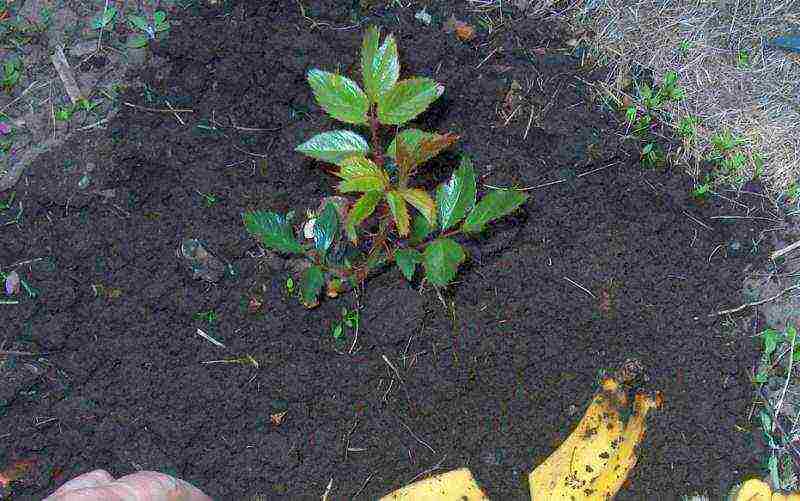
Rules for feeding bushes in spring
Top dressing of roses in spring is carried out in several stages.
- The first is done immediately after pruning the bush. In this case, nitrogen fertilizers are used - Aquarin, Aquamix. Experienced gardeners recommend using solutions, as they penetrate the soil better. Under each bush, you need to add 3.5 liters of funds. It is more difficult to add dry substances. To prevent them from eroding, it will be necessary to carry out mulching. For each bush, 40 g of dry matter is applied. First, mineral fertilizers are applied, then it is the turn of the introduction of organic substances, as a rule, they wait a day between dressings. The amount of application of substances depends on the variety of the rose.
- The second feeding is done after the young shoots have formed. As a rule, this happens 14 days after the first feeding. Organic substances are used as fertilizers - manure, herbal infusions. You can also use minerals for feeding. In this case, 1 spoon of urea and other fertilizers in the amount written on the package are taken per bucket. First, the soil is well spilled, then top dressing is applied. Only in this way the roots of the plant will not be burned.
- The third feeding is done before the buds appear. A solution of potassium nitrate is introduced under the bush. Dilute it as follows - 1 tbsp dissolves in a bucket of water. l. potassium nitrate. After the introduction of minerals, organic matter is introduced - it is prepared in the same proportions, but using potassium magnesium.
Rose care: feeding (video)
To grow roses, you need to choose them correctly, paying attention, first of all, to the root system when buying. After that, you should correctly plant the plants, as well as provide them with high-quality care - water and fertilize in a timely manner. Planting roses in the spring, no matter whether it is obtained by the method of "propagation by layering" or otherwise, is qualitatively different from planting them in the fall, it is also worth paying close attention to so that the seedlings take root.
Attention, only TODAY!
Reviews and comments
Dates of planting container planting material in spring and autumn
Thanks to modern technologies, many nurseries have the opportunity to grow planting material in containers before selling.
- This means that the roses are dug up in advance and kept in special containers.
- There they take root, that is, they grow new hair-like roots.
- In this form, they are delivered to their destination.
This method guarantees the safety of plants during transportation and storage. Such shrubs can be

Roses with a closed root system are planted at any time of the year.
plant at any time of the year, and they will definitely take root.
Advantage Roses with a closed root system is that the planting period in spring is significantly increased compared to traditional seedlings, in which the roots are bare.
Ordinary roses are planted in open ground when it warms up to + 100. And plants with a closed root system may not wait for heat.
- Planting is possible from early spring to late May.
When is it better to plant roses with a lump in autumn

Before being sent for sale, the seedlings must root, forming a ball.
And if the gardener has not invested in the deadline, then the work can be continued in the summer. There are a few more advantages to this:
- Unmistakable variety identification, which is guaranteed to be established during flowering. The dream of the great gardeners of the past centuries about rooting roses with blooming buds has come true.Many varieties bloom for a long time, all summer and most of autumn. This does not interfere with the survival of roses with a closed root system.
- The agrotechnology of growing woody plants with a lump allows transport planting material to any part of the world.
Although closed-rooted roses can be planted in any season, it is still best to do this when the plants are growing, such as in the fall.
Previously, choosing the right time for the autumn work was problematic.
- If you plant roses too early, new shoots may sprout, they will not get stronger until the cold and freeze.
- With late planting, the seedling did not have time to root until frost.
There are no such problems with container plants. At first, they adapt at the expense of their own coma, in their familiar environment. What allows you to plant roses from early September to frost, unlike seedlings with open roots, in which this period is limited by weather conditions.
General principles of preparing plant soil in a planting pit
No matter what time of the year roses with a lump are planted, the preparation of the pit is carried out in the same way.
It is important to remember about the size of an adult plant, the size of the planting depends on this.
| For miniature and patio varieties | 30 cm x 30 cm x 30 cm |
| For hybrid tea, floribunda, climbing and other large roses | 50 cm in diameter, 60 cm in depth |
All varieties of roses grow best in fertile soils. These are rarely found in summer cottages, so improving additives need to be added to the natural soil (See also the article ⇒ Three recipes for compost).
For sandy:
| Clay soil (black soil) | 2 parts |
| Humus | 1 part |
| Compost | 1 part |
For clayey:
| Coarse sand | 1 - 2 buckets |
| Or grass peat | 3 - 4 buckets |
| Humus | 1 - 2 buckets |
Tip # 1. Pay attention! The recommended doses of improving additives are indicated for one landing pit, measuring 0.5 mx 0.5 mx 0.6 m.
You need to prepare a place for planting a rose in advance, do not
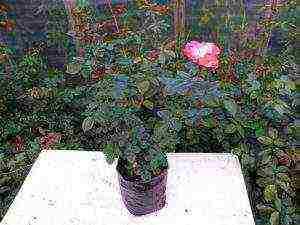
Many varieties are still blooming at this time, but this does not interfere with the survival of roses, with a closed root system.
later than a month. During this time, the soil will settle down, and the nutrients will partially dissolve.
Before placing the plant in the pit, it must be properly removed from the container in which it was stored.
Optimal preparation of the planting pit with the introduction of organic fertilizers is carried out five to six months before planting. Point Optimize the soil correctly:
The seat is prepared as follows:
- The most fertile topsoil, 25-30 cm deep, is laid in one direction, and deeper poor soil in the other. It is he who has to be optimized.
- Drainage from small pebbles and sand is laid at the bottom of the pit. The top fertile layer is placed on it.
- The remaining soil is mixed with improving additives, and sent to the pit (See also the article ⇒ What size to dig a hole for a rose).
In this form, the seat is defended for several months.
Before the start of planting, a depression is formed, the size of which is 2 times the size of the coma. This allows you to freely place a lump in the pit, sprinkle it with nutritious soil, and thoroughly compact it.
Tip # 2... When planting, the rose in the pit must be placed so that the top of the coma is 2 to 3 cm above the edge of the pit. After the soil subsides, the root collar will be at the desired level.
- After planting, a circle is formed around the bush from a compacted roller of earth. It is needed in order to retain water when watering. Irrigation of the planted plant should be abundant. You will need 20 - 25 liters of water. It is necessary to completely moisten the entire clod and the soil around it.
How to properly remove an earthen lump from a transit container
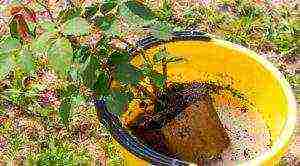
A hard container is briefly placed in a bucket of water to moisten the lump. Then it is easier to remove from the pot. It is not necessary to keep the plant in water for too long, otherwise the lump will get wet and crumble.
In order for a rose with a lump to take root well, it is important to carefully remove it from the package so as not to damage the hairy roots.
Capacities are different:
- Elasticsuch as plastic bags.
- Hard - plastic pots or containers.
The former are used for small plants, the latter, as a rule, accommodate larger planting material.
Before removing the package, the lump is watered abundantly in it. Plants are removed from the container just before planting.
- The flexible shell is carefully cut on both sides and the lump is opened. Transfer to the pit with both hands, holding the root system.
Tip # 3... Note! When removing the plant from the container, do not pull on the stems. So you can pull him out of the coma. Before removing the rose, the container is slightly crumpled from the sides and turned over. Holding the inverted pot with one hand, the other is substituted under the stems of the plant. In this position, the lump separates from the container completely freely.
- All work is carried out in the immediate vicinity of the planting pit, so that the plant can be immediately placed in a permanent place, without additional carrying.
Category: "Questions and Answers"
Question number 1.
Up to what age to transplant roses with a lump?
The peculiarities of preparing plants with a lump for transportation of topics are unique in that woody plants have no age restrictions for transplanting. Modern technology allows you to preserve the root system of mature trees and shrubs. Now they transport and plant planting material with a lump up to 1 m in diameter. This is more than enough to translate a rose of any size, no matter how old it is.
Gardeners' mistakes when planting shrubs with a lump
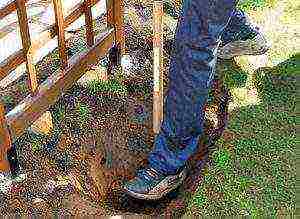
Preparing a planting hole for a rose with a ball is the same as for a seedling with an open root system.
- Plant roses with a closed root system without preliminary preparation of the planting pit.
Some gardeners believe that a plant can live its entire life due to a coma. It's a delusion. At first, the bush does with a small amount of nutrition in its soil. When roots grow outside of their familiar environment, they should end up in a fertile environment. It must be provided in advance, after filling the planting hole with rich soil. If this is not done, then the rose will react negatively to an unfavorable environment, up to death.
- Remove the rose from the container by pulling the aboveground part of the bush.
If you remove the plant from the container in this way, you can easily damage the lump. Then it will not be a rose with a closed root system, but an ordinary seedling with open roots. These take root more difficult. And they do not take root at all in the wrong time frame for them. Not to mention the fact that roses with a lump are much more expensive than planting material with bare roots.
- Insufficient watering after planting.
Assuming that the lump is wet before planting, some gardeners use a little water. The amount of irrigation should be such as to completely wet the soil in the planting pit to its full depth.
- This compacts the soil and prevents air pockets from forming.
- Provides the dissolution of nutrients for a long time, which improves the rooting of the plant. Hairy roots expand faster in moist soil.
Recommendations of experts on the preparation of the root system of container plants for planting
It is impossible not to damage the roots at all when removing the plant from the container. But in order for the damage to be minimal, it is important to keep it intact. Before removing the plant from its packaging, it must be thoroughly watered or lowered into a bucket of water.
In order for the lump to slip freely, the pot is crumpled from the sides, and, turning it sideways, lightly hit. This allows the coma to separate from the container walls.
If roots have sprouted through a hole in the bottom of a rigid pot, they are cut off with a sharp knife so that they do not interfere with reaching the plant.
Flexible packaging is easier to handle.Several lateral longitudinal cuts are made to easily remove from the coma.
Based on the recommendations of the “Catalog of Plants. Trees and shrubs recommended by the Union of Polish Nurseries ", Varshava - 2007. Jacek
The author of the article - Jacek Waughrowski - Leading dendrologist at Agenncji Promocji Zieleni.
A selection of tips for growing roses
Presented the best tips in pictures for planting, care, pest and disease control in roses ⇓
Rate the quality of the article. We want to be better for you ⇓:


